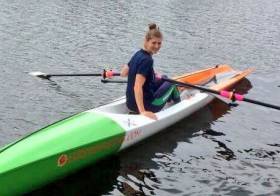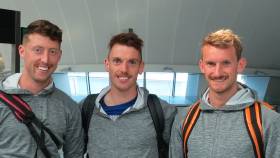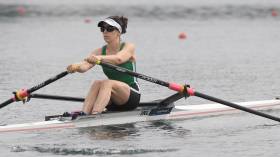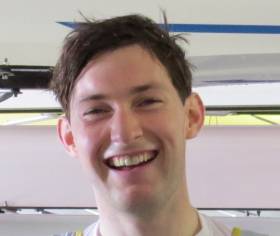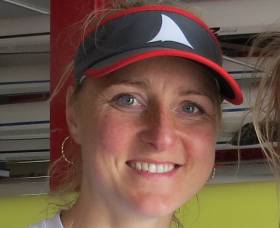Displaying items by tag: Ireland
Silver for Ireland's Dukarska at World Coastal Rowing
#Rowing: Ireland’s Monika Dukarska took silver at the World Coastal Rowing Championships in Thonon on Lake Geneva in France. The Killorglin woman held second for virtually the entire race behind Diana Dymchenko of Ukraine, who shot into an early lead and held it all the way to the end to take gold. The two fought a battle at the front of the field, but Dukarska could not close the clearwater gap Dymchenko had opened.
Earlier, Castletownbere had finished 14th in the women's coxed quadruple - they were moved up one place in the revised resutls.
World Coastal Rowing Championships, Thonon, France, Day Two (Selected Results; Irish interest)
Men
Solo – A Final: 1 Italy (Padova; S Martini) 28:13.67; 18 Ireland (Arklow; J Casey) 32:12.72; 20 Ireland (Castletownbere; A Sullivan-Greene) 33:14.91; 21 Ireland (Bantry; A Hurley) 34:22.78.
Women
Quadruple, Coxed – A Final (Revised Result): Greece (Nautical Club of Thessaloniki) 27 min 34.98, 2 Italy (CC Saturnia) 27:41.49, 3 Germany (Erster Kieler RC v 1862e V) 27:49.29; 15: Ireland (Castletownbere: E Hanley, C O’Regan, O Gilsenan, M Sheehan; cox: C Connolly) 30:42.58. B Final: 1 Ireland (Galley Flash) 20:46.06, 2 Ireland (Cairndhu) 20:56.34.
Double – B Final: 2 Arklow 21:08.80.
Solo – A Final: 1 Ukraine (Concord; D Dymchenko) 29:58.40, 2 Ireland (Killorglin; M Dukarska) 30:30.78, 3 France (Team Chablais Aviron; E Alfred) 30:54.44; 15 Ireland (Arklow; S Healy) 34:16.49. B Final: 2 Ireland (Killorglin: J Lee) 23:39.30.
Castletownbere Fly Flag for Ireland in A Final at World Coastal Rowing
#Rowing: Castletownbere, representing Ireland, finished 14th in the A Final of the women’s coxed quadruple at the World Coastal Rowing Championships in Thonon on Lake Geneva in France.
Greece won an exciting race, recovering from a mistake to take over the lead from Germany by the eighth buoy. Italy pushed into second, while Germany clung on to third. They held off Russia, who had led early in the race, by .36 of a second. Galley Flash won the B Final, and Cairndhu finished second.
Jessica Lee had finished second in the B Final of the women’s solo.
World Coastal Rowing Championships, Thonon, France, Day Two (Selected Results; Irish interest)
Women
Quadruple, Coxed – A Final: Greece (Nautical Club of Thessaloniki) 27 min 34.98, 2 Italy (CC Saturnia) 27:41.49, 3 Germany (Erster Kieler RC v 1862e V) 27:49.29; 14: Ireland (Castletownbere: E Hanley, C O’Regan, O Gilsenan, M Sheehan; cox: C Connolly) 30:42.58. B Final: 1 Ireland (Galley Flash) 20:46.06, 2 Ireland (Cairndhu) 20:56.34.
Solo – B Final: 2 Killorglin (J Lee) 23:39.30.
World Rowing Gold Medallists Return
#Rowing: Ireland gold medallists Paul O’Donovan, Shane O’Driscoll and Mark O’Donovan arrived back in Ireland today from the World Rowing Championships in Florida. They flew from Orlando to Dublin where family and friends greeted them. They were accompanied by Gary O’Donovan, an Olympic medallist in 2016 and reserve for the World Championships team. This evening they will be honoured at a reception in Skibbereen.
Ireland's Golden Boys Set To Return after World Rowing Championships
#Rowing: The Ireland gold medallists Mark O’Donovan and Shane O’Driscoll and Paul O’Donovan are due to arrive back in Ireland tomorrow (Sunday). They are due in Dublin Airport at about 10 o’clock. They will travel to Skibbereen for a special event in the evening.
Gary O’Donovan, who took a silver medal at the Olympic Games but missed the World Rowing Championships in Florida through illness, will also be flying in.
Puspure Just Outside Medal Pace at World Rowing
#Rowing: Sanita Puspure finished fourth in the A Final of the women’s single sculls at the World Rowing Championships in Sarasota-Bradenton in Florida.
Switzerland’s Jeannine Gmelin prospered in the difficult conditions, taking gold ahead of Victoria Thornley of Britain. Austria’s Magdalena Lobnig held off a late sprint by Puspure to take bronze. Puspure was just .35 of a second behind.
The lanes had been redrawn because of wind, placing Puspure in lane four. She had been drawn in two, but the higher-numbered lanes were thought to have an advantage. Lobnig, who has shown herself to be a good performer in choppy water, survived a wobble in the middle of the race when her oar did not make proper contact with the water.
World Rowing Championships– Irish interest
Women
Single Sculls – A Final: 1 Switzerland (J Gmelin) 7:22.58, 2 Britain (V Thornley) 7:24.50, 3 Austria (M Lobnig) 7:26.56; 4 Ireland (S Puspure) 7:26.91, 5 Netherlands 7:32.69, 6 Canada 7:35.93.
Brilliant Gold Medal for O'Driscoll and O'Donovan at World Rowing
#Rowing: Ireland’s lightweight pair of Mark O’Donovan and Shane O’Driscoll took a brilliant gold medal at the World Rowing Championships in Sarasota-Bradenton in Florida. They got a tough challenge from Italy and Brazil, but O’Donovan and O’Driscoll produced a stunning row, with a stroke rate of well into the 40s right through the race. They took over the lead at 750 metres and never gave it up, despite concerted challenges by, first, Brazil and then Italy, who took second, with the South Americans taking bronze.
Walsh Continues Winning Run for Ireland at World Championships
#Rowing: Denise Walsh took an excellent first place in her semi-final at the World Rowing Championships in Sarasota Bradenton in Florida today, making it two wins out of two races for Ireland on the day.
The Skibbereen lightweight sculler took a slight lead over Mary Jones at half way, with Emma Fredh of Sweden in third. These three then moved away from the rest. Walsh would not let either challenger head her – at the finish the trio finished in the same order, with less than a second covering them.
Kirsten McCann of South Africa won the first semi-final from Patricia Merz of Switzerland.
Earlier, Paul O’Donovan had won his semi-final of the lightweight men’s single sculls.
World Rowing Championships, Sarasota-Bradenton, Day Five – Irish interest:
Men
Lightweight Single Sculls – A/B Semi-Final One (First Three to A Final; rest to B Final): 1 Ireland (P O’Donovan) 6:55.30, Switzerland (E Schmid) 6:59.04, 3 Brazil (U Batista) 7:00.47.
Semi-Final Two: 1 Norway (K Brun) 6:54.02, 2 New Zealand (M Dunham) 6:55.68, 3 Germany (L Wichert) 6:57.11.
Women
Lightweight Single Sculls – A/B Semi-Final Two (First Three to A Final; rest to B Final): 1 Ireland (D Walsh) 7:45.89, United States (M Jones) 7:46.54, Sweden (E Fredh) 7:46.78.
Semi-Final One: 1 South Africa (K McCann) 7:39.55, 2 Switzerland (P Merz) 7:39.63, 3 The Netherlands (M Keijser) 7:49.17.
O'Donovan Wins Semi-Final and Brazil Snatch Place at World Rowing
#Rowing: Paul O’Donovan took first in his semi-final and qualified for the A Final at the World Rowing Championships in Sarasota Bradenton in Florida today. The Skibbereen man came through in a race with an exciting finish. Michael Schmid of Switzerland led through halfway, but O’Donovan tracked him and drew level at 1500 metres. He passed him in the next few strokes and went on to win by over a length. Behind the two, Uncas Batista of Brazil took the final qualification spot – after Poland’s Artur Mikolajczewski completely ran out of steam approaching the line.
World Rowing Championships, Sarasota-Bradenton, Day Five – Irish interest:
Men
Lightweight Single Sculls – A/B Semi-Final (First Three to A Final; rest to B Final): 1 Ireland (P O’Donovan) 6:55.30, Switzerland (E Schmid) 6:59.04, 3 Brazil (U Batista) 7:00.47.
Puspure Cruises Through to World Rowing Semi-Finals
#Rowing: Sanita Puspure won her repechage to qualify for the A/B Semi-Finals of the women’s single sculls at the World Rowing Championships in Sarasota-Bradenton today. The Ireland sculler was out on her own for virtually the entire 2,000 metres. She had three lengths over Lucie Zabova of the Czech Republic in the middle of the race and extended it to four by the finish. Both qualified.
In a major surprise Juan Dingli of China could only finish third in the second repechage and misses out on the chance of an A or B Final appearance.
The Ireland women’s pair of Aifric Keogh and Aileen Crowley finished fourth in their repechage, and will compete in the B Final. They were up with the leaders in the first 500 metres, but Britain and then Germany moved away from them and took the qualification places for the A Final. In the third quarter, China passed Ireland and held on to third despite a good finish by Crowley and Keogh.
World Rowing Championships, Sarasota-Bradenton, Florida – Day Four – Irish Interest:
Women
Pair – Repechage (First Two to A Final; rest to B Final): 1 Britain 7:25.99, 2 Germany 7:3.34; 4 Ireland (A Keogh, A Crowley) 7:41.13.
Single Sculls – Repechage (First Two to A Final; rest to B Final): 1 Ireland (S Puspure) 7:36.16, 2 Czech Republic (L Zabova) 7:45.98.
Boomer and McQuillan-Tolan Fifth in World Rowing Repechage
#Rowing: The Ireland pair of Fionnán McQuillan-Tolan and Patrick Boomer finished fifth in their repechage today at the World Rowing Championships in Florida. They will compete in the C Final. The top three secured places in the A/B Semi-Finals. Serbia were impressive winners, taking over from Spain in the middle stages. These two held the top spots to the finish. Behind them the United States clung on to third.
Ireland pushed fourth-placed Argentina hard in the third quarter, but it was the South Americans who finished best – they came close to ousting the United States and taking the crucial third spot. The host country held on by just .35 of a second.
World Rowing Championships, Sarasota-Bradenton, Florida – Day Three (Irish interest):
Men
Pair – Repechage (First Three to A/B Semi-Final; rest to C Final): 1 Serbia 6:38.05, 2 Spain 6:40.24, 3 United States 6:41.46; 5 Ireland (F McQuillan-Tolan, P Boomer) 6:47.01.


























